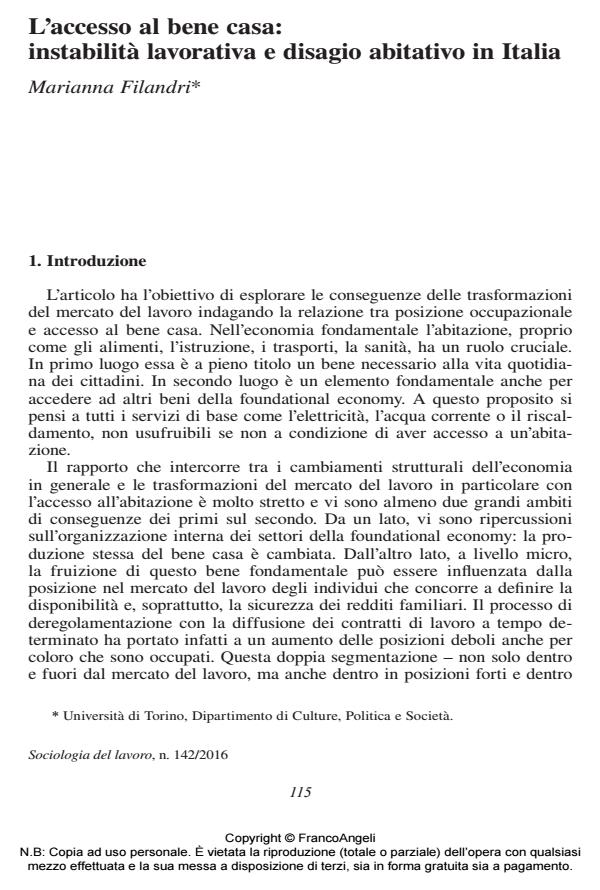Access to the house: job instability and housing deprivation in Italy
Journal title SOCIOLOGIA DEL LAVORO
Author/s Marianna Filandri
Publishing Year 2016 Issue 2016/142
Language Italian Pages 15 P. 115-129 File size 114 KB
DOI 10.3280/SL2016-142007
DOI is like a bar code for intellectual property: to have more infomation
click here
Below, you can see the article first page
If you want to buy this article in PDF format, you can do it, following the instructions to buy download credits

FrancoAngeli is member of Publishers International Linking Association, Inc (PILA), a not-for-profit association which run the CrossRef service enabling links to and from online scholarly content.
The article investigates the relationship between job security and the housing conditions. The deregulation process with the widespread of temporary jobs has led to an increase in weak positions for employees and has major implications on the safety of household’s income. The instability of income may hinder investments in the housing conditions that are at the basis of living in an adequate house. To investigate the influence of job instability and level of income on housing problems, we analyze the Italian data of the European Union Statistics on Income and Living Conditions for the year 2011. The results show that the disadvantage of having an insecure income affects more than economic level, the chances of suffering from poor housing.
Keywords: Inequality, housing, housing deprivation, temporary employment, income security, foundational economy
- Ance (2014). Osservatorio congiunturale sull’industria delle costruzioni. Roma: ANCE.
- Ayala L., Navarro C. (2007). The dynamics of housing deprivation. Journal of Housing Economics, 16: 72-97.
- Barbieri P., a cura di (2009). European Sociological Review. Atypical employment in Europe. Oxford: Oxford University Press.
- Barbieri P., Scherer S. (2005). Le conseguenze sociali della flessibilizzazione del mercato del lavoro in Italia. Stato e Mercato, 74: 291-322.
- Barbieri P., Scherer S. (2007). Vite Svendute. Uno sguardo analitico alla costruzione sociale delle prossime generazioni di outsider. Polis, 3: 431-60.
- Bartus T. (2005). Estimation of Marginal Effects Using Margeff. Stata Journal, 5: 1-23.
- Bertolini S., Di Pierro D., Richiardi M. (2007). Giovani e nuove forme di lavoro. Un’indagine sugli utenti dei Cpi. In: Berton F., Contini B., a cura di, Le nuove forme di lavoro in Italia e in Piemonte: nuove opportunità o discriminazione? Torino: Rapporto di ricerca per la Fondazione Crt e la provincia di Torino.
- Biagioli M., Reyneri E., Seravalli G. (2004). Flessibilità del mercato del lavoro e coesione sociale. Stato e Mercato, 71: 277-313.
- Bowman A., Ertürk I., Froud J., Johal S., Law J., Leaver A., Moran M., Williams K. (2014). The end of the experiment? From competition to the foundational economy. Manchester: Manchester University Press.
- Brandolini A. (2005). La disuguaglianza di reddito in Italia nell’ultimo decennio.
- Stato e Mercato, 74. Ance (2014). Osservatorio congiunturale sull’industria delle costruzioni. Roma: ANCE.
- Ayala L., Navarro C. (2007). The dynamics of housing deprivation. Journal of Housing Economics, 16: 72-97.
- Barbieri P., a cura di (2009). European Sociological Review. Atypical employment in Europe. Oxford: Oxford University Press.
- Barbieri P., Scherer S. (2005). Le conseguenze sociali della flessibilizzazione del mercato del lavoro in Italia. Stato e Mercato, 74: 291-322.
- Barbieri P., Scherer S. (2007). Vite Svendute. Uno sguardo analitico alla costruzione sociale delle prossime generazioni di outsider. Polis, 3: 431-60.
- Bartus T. (2005). Estimation of Marginal Effects Using Margeff. Stata Journal, 5: 1-23.
- Bertolini S., Di Pierro D., Richiardi M. (2007). Giovani e nuove forme di lavoro. Un’indagine sugli utenti dei Cpi. In: Berton F., Contini B., a cura di, Le nuove forme di lavoro in Italia e in Piemonte: nuove opportunità o discriminazione? Torino: Rapporto di ricerca per la Fondazione Crt e la provincia di Torino.
- Biagioli M., Reyneri E., Seravalli G. (2004). Flessibilità del mercato del lavoro e coesione sociale. Stato e Mercato, 71: 277-313.
- Bowman A., Ertürk I., Froud J., Johal S., Law J., Leaver A., Moran M., Williams K. (2014). The end of the experiment? From competition to the foundational economy. Manchester: Manchester University Press.
- Brandolini A. (2005). La disuguaglianza di reddito in Italia nell’ultimo decennio. Stato e Mercato, 74.
- Le politiche di conciliazione tra residualità e frammentarietà. Il caso di un co-working con spazio baby a Roma Giovanna Campanella, Luisa De Vita, in SOCIOLOGIA E POLITICHE SOCIALI 1/2018 pp.97
DOI: 10.3280/SP2018-001007
Marianna Filandri, L’accesso al bene casa: instabilità lavorativa e disagio abitativo in Italia in "SOCIOLOGIA DEL LAVORO " 142/2016, pp 115-129, DOI: 10.3280/SL2016-142007